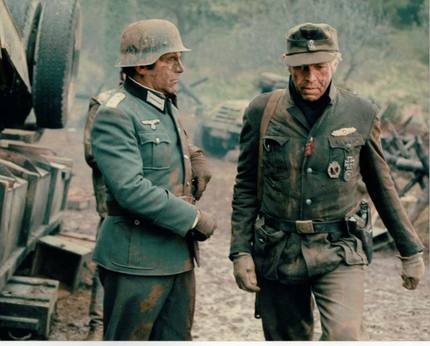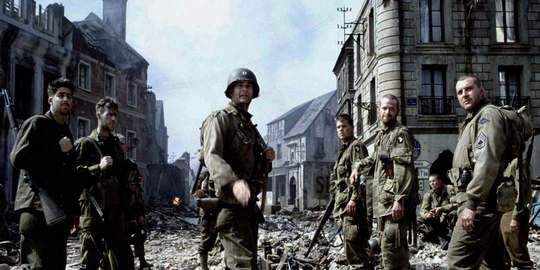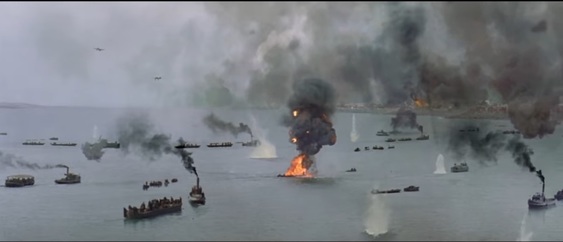|
Having written previously about the most historically accurate military history films, I received feedback asking, what are other war movies with good to fair historical accuracy? So I ran the Geiger counter over some of the better WWI and WW2 films. Hollywood has made scores of war dramas set during the two World Wars of the violent century, but most are not especially known for a high degree of historically accuracy. I have picked out eight films that do not rank in the best-in-class for historical accuracy, yet these films stay true to the times, places and basic historical facts without any jarring errors or anachronisms. Some are based on mere novels that historians more High Church than myself would dismiss. However, when the novel is authored by a war veteran, and he knows exactly what he is talking about, it imparts an interesting first-hand knowledge on the subject that adds a sense of realism as much or more than some movies based on a true, or non-fiction, storyline. Other films in this post are at least partially based on true stories, yet are embellished for obvious box office reasons. These eight war movies make for good stories about WWI & WW2 with plenty of drama and action. And most importantly are very entertaining. The following reviews are in order by release dates. Learn some Military History and enjoy these films!
1. Hell is for Heroes 1962
With half a dozen BTWF actors that would later dominate the big screen and TV in the 60’s, this low budget movie is an underrated gem. The cast is outstanding; Steve McQueen (Reese) is at his best here; the cool loner packing a .45 cal. M3 “Grease Gun”, James Coburn (Henshaw) on the Flamethrower, Fess Parker (Sgt. Pike) on the M2 carbine, Kolinsky on the BAR, and the rest of the boys toting M1 Garand rifles. Enhanced with a low-key, effective soundtrack and welcome comic relief (movie debut by Bob Newhart) this movie nails the bull’s-eye for action fans. My father was an infantryman in the U.S. 9th army, and fought the Nazis for two years across France, Belgium and Germany. We saw this movie together, and he was impressed with the realism of the film. He said that the film captured the time period and atmosphere better than any other WWII film he had watched. So for me, this movie is as good as it gets for an intense tale of WWII small unit combat operations – American GIs versus German Landsers, circa 1944/5.
2. The Blue Max 1966
If you like aviation and military history, watch this big-budget WW 1 historical drama. This film is legendary in the annals of air combat movies for its reality as well as the skill and daring that went into the production. Filmed 40+ years after the war ended, there were no airworthy WWI warplanes available for use, so the studio contracted to hand-build two air forces from scratch copying the original German and British fighter aircraft plans as closely as possible. Next they hired the best stunt pilots in the business then off they went to Ireland to make a movie. The cost was immense, but worth every penny. The storyline is entirely from the German point of view. George Peppard does a good job of playing the lead character, ace fighter pilot Bruno Shachel. In fact, Peppard was so keen on the role that he learned to fly, and did some flying in the movie. Of course, the stunt pilots handled the tricky flying, and there was plenty of that to do. The writers had the brilliant idea of a dramatic bridge fly-through. The stunt pilots frowned on the idea, but it wouldn’t go away. Finally, the ideal bridge was found in a rural area of southern Ireland. The bridge spanning the Blackwater River is a stately railway viaduct with wrought-iron lattice girders supported by massive stone pillars with enough room for a fly through – for an expert pilot. Derek Piggott, an RAF war veteran, was the fearless man who volunteered for the challenge, and got the job done. CGI simply can’t compete with real pilots flying vintage biplanes right into the danger zone. We will never see its likes again. A Blue Max for Derek!
3. Cross of Iron 1977
The film is an adaptation of the novel, by the same name, penned by a Wehrmacht combat veteran named Willi Heinrich. Willi fought on the Russian steppes from 1941 to 1945 and was lucky to survive the war. James Coburn is exceptional in the lead role as Steiner, a battle hardened German Landser on the WWII Eastern front. This is his finest performance in a career that spanned over four decades. He is well supported by James Mason and Maximillian Schell who both do the best they can with what they have to work with. The Eastern front combat scenes ring true. The uniforms, weapons, tanks and tactics are historically accurate. The German ambushes and the Soviet tank attack are well-made battle scenes that capture the look and feel of real danger. And, yes those were actual Russian T-34 tanks, not fakes. The movie is not without flaws – it is overlong, and detours into war movie cliché-land when our wounded hero is evacuated to a field hospital where he falls in love with a lovely nurse. You may want to keep your finger hovering over the FF button.
4. Das Boot 1981
One of the greatest war films ever made. It chronicles a German U-boat voyage as the war begins to shift in favor of the Allies. The performances from all actors are believable, and the production sets capture the look and feel of a damp iron coffin. The war weary German sailors are sent out to sea again and again to face an Allied navy that is steadily improving tactics and weapons. Students of WWII history know that the allies broke the German Naval Enigma code, and used the intel to defeat the U-boat fleet. These German sailors we are watching are doomed, but they still maintain their fighting spirit. The tensions rise, nerves are shattered; fear and panic overwhelm the crew. It leaves you glad that you can walk outside and look up at blue sky. Best seen in the original German, it's so realistic that you may as well have the correct language and nuances. Grim but great, this is the best submarine film of all time. Based on the novel written by a German war journalist who sailed in U-boats.
5. Saving Private Ryan 1998
On June 6, 1944 American, British and Canadian assault troops crossed the English Channel, landed on multiple beachheads at Normandy France, and invaded Nazi occupied Europe. This movie grabs you by the collar and flings you into the chaotic violence of D-Day with more realism than most of us can imagine, or perhaps desire. The opening act in this film takes place on Omaha Beach, and includes the most spectacular WW2 battle scene ever filmed. As we follow a rifle team on a rescue mission, the fighting continues on a smaller scale, but the action never falters. Many people ask about the authenticity of the storyline. In real life an American paratrooper, Pvt. Niland, jumped into France on D-Day and was later pulled out of combat for the reasons explained in the film (Family Survivor Act). That much is historical fact, but the studio pundits have been steadfast in refusing to explain the basis of the story. I believe it is the story of Private Niland with some names changes and a vastly sensationalized rescue mission for obvious box office reasons.
6. Enemy at the Gates 2001
There are marksmen, and there are expert marksmen who have the gift. This is a movie about a Russian expert marksman in the Battle of Stalingrad. A few facts for some historical perspective: Fact – Stalingrad was the critical battle on the Eastern front in WWII. Fact – the 6+ month long battle was the bloodiest in modern history. Fact – Vasily Zaitsev was a deadly sniper and he killed a lot of Germans. Almost everything else in this movie is invented or unrealistic. The main plot - a sniper duel between Zaitsev and Konig - is Soviet era propaganda, and has been thoroughly debunked by modern historians. And the idea that Zaitsev "won the battle" in a sniper contest is beyond absurd. He was part of the delaying forces in the city until a huge flanking counterattack, with hundreds of Russian tanks, crossed the frozen Volga River, cut the German supply lines and decided the battle. Nazi air chief, Herman Goring, announced he would supply the encircled army by air. He failed. The Soviets starved the Germans until they surrendered on Feb 02, 1943. The battle was a major turning point in the war. It took two more years of hard fighting to finally defeat the Nazis, but they were mostly on the defensive after Stalingrad. That said, the movie is entertaining, the acting is good, the scenery and costumes look very realistic, and the battle scene with the Soviet assault troops crossing the Volga River is unforgettable.
7. War Horse 2011
Few scenes are more exciting on the big screen than watching a herd of hard galloping horses and hearing the thunder of pounding horse shoes rumbling in the mega bass surround sound. For my money, that is the best part of this boy-loves-horse film. Sure, we have seen the genre before and know the formula by heart. We know how the movie must end. Doesn’t matter; I wasn’t expecting Citizen Kane. The production design is first class, with impressive, full-scale WW I battle scenes that replay in the mind for days afterward. We see British cavalry in a no-holds-barred charge straight into the teeth of a battery of German machine guns; British infantrymen charging into No Man’s Land to the tunes of the regiment bagpipes, and the star of the movie, Joey the warhorse, bolting recklessly through the crowded trenches and barbed-wire laced battlefield. From beginning to end, "War Horse" is a beautiful film to look at. The film is not without some stagey overacting, Oscar baiting and near comic melodrama. In the tearjerker ending, we watch the misty-eye boy’s lips quivering at the inevitable, emotional reunion with the war horse. We can almost hear him blubber_ just give me the damn Oscar. If any of the cast should have won an award, it was the warhorse. What a beast!
8. Monuments Men 2014
To the victors go the spoils of war. The Nazis believed in that old saw to the bottom of their tar black hearts, especially German big shot Herman Goering who remarked, “I intend to plunder, and plunder thoroughly.” In his heyday, Herr Goering had enough stolen art work at his private estate to fill a world class art museum. This movie is based on the true story of the MFAA (Monuments, Fine Arts and Archives) unit, and recounts some amazing and largely unknown WWII history about the efforts by the Americans and British militaries to recover/protect Fine Arts then return same to rightful owners. Who knew? While the film is based on Robert Edsel's book Monuments Men: Allied Heroes, Nazi Thieves and the Greatest Treasure Hunt in History, a few artistic liberties were taken on the final screenplay. The movie version changes names and invents some action scenes for obvious box office appeal, but does not distort the important historical facts. To quote writer/director/actor George Clooney, the movie is about 80% accurate to the true story told in the book.
|
AuthorWritten by Ben Clark. Copyright 2016-2023. All rights reserved. Check out my new book, available on Amazon Kindle!Archives
February 2022
|








